January 2009 Cub Scout Roundtable Issue |
Volume
15, Issue
6
February 2008 Theme |
Theme:
American ABC's
Webelos:
Scholar and Engineer
Tiger Cub Activities |
WEBELOS
Webelos Resident Camp
It is not too early to think about this!!!
Webelos Resident Camp is many
things -- the sounds of boys laughter doing fun events and activities. Resident
Camp involves the type of programs that can be hands on for the boys. Programs
are designed for a Webelos Scout and a parent (or other adult) to spend time
together and enjoy a few days of camping.
The purpose of Webelos Scout
Resident Camping is to have fun and to instill in the Webelos a desire to want
to continue to camp. Webelos Resident Camp is typically for boys going into
grades four (This year's Bears) and five (This year's Webelos 1's) next fall.
These Scouts will be your first and second year Webelos Scouts next fall.
Webelos Resident Camps generally offer a wide variety of activity badges. Some
work on a two-year cycle.
Webelos Resident Camp can
include: camping, campfires, swimming, cookout meals, archery, bb-guns
(Starting in 2009 BSA says Webelos can use Pellet Guns!!), hikes,
ecology study, geology, star study, Scout's Own religious service, sports games
and much more. The boys are kept busy and have a great time. (Especially in
Southern NJ Council!! We have Cub-Anapolis Races, Water Bottle Rockets,
Conservation, Movie Night, Root Beer Floats, Retro Day (50's & 60's or
whatever), Hooked on Hockey presentations. They build their own camp stool and
cook their lunches almost every day!!
Find out about your council's Webelos Resident Camp!!
And be there, this summer!!
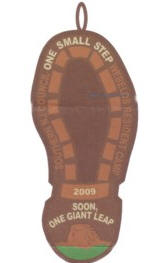
SCHOLAR
MENTAL SKILLS GROUP
Den Activities
Circle Ten
Council
·
Let the boys talk about what's going on in school. Don't try to
change any of their ideas, but guide the discussion in such a way that they will
see the value of an education.
·
Learn about the history of education, how schools developed in
America.
·
Prepare a chart of the school system and explain and discuss with
boys.
·
Discuss & do a den service project for the school.
·
Invite the parents of Webelos to come to a den meeting dressed in
the type of clothes they wore to school. Have them bring along such things as
class pictures, yearbooks, report cards, etc. and allow each ample time to share
his/ her school days with the den.
·
Have a panel of parents with various jobs explain their schooling
and training for these jobs.
·
Invite an educator to talk with the den about some of the scholar
requirements.
·
As a den, talk about good study habits.
·
Have someone from the public library talk about the local literacy
project.
·
Tour a local high school or visit a local college campus.
·
Play a Newspaper Search game looking for articles about education.
·
Encourage boys to find out all they can about schools in your
community ... the different types and how they work... the problems and
opportunities. Discuss these at a den meeting. Have the boys make a list of the
things they like about school and another list of the things they don't like
about school. Give these lists to the principal.
·
Have the boys make a daily time schedule and use it to determine
if they are making the best use of their time.
Careers in
Education
Circle Ten
Council
Have each boy choose one career in education and think of
what may be involved in that career. Have them make a collage of pictures that
relate his ideas about that career. You may be surprised at a Webelos Scout's
perception of some of these jobs. When done, discuss them and clarify any
misconceptions.
Speakers
Circle Ten
Council
Teacher
College professor
School principal
Librarian
Additional ideas:
Circle Ten
Council
Invite a member of the school
board or a professional educator (teacher or principal) to talk to the boys on
the value of an education and what school has to offer a boy.
Have the boys try to find out some of these things:
·
What jobs are there at school for the boys to do?
·
What extra-curricular activities are available?
·
What community activities is the school used for?
·
Who are the people on the office staff, cafeteria staff, and
custodial staff? What are their responsibilities?
·
What are some of the problems of the school, and how can you help?
Have the boys list what they consider the best and worst
things in their school. Arrange to give these lists to the principal or a school
board member. Invite them to a den meeting to talk with the boys. Important to
the participants in such a meeting is a feeling of trust and comradely. Allow
the meeting to have an informal setting. After respectfully introducing the
guest, let it become an informal rap session. A few cookies and punch served by
the Denner has worked wonders in the past. Now is the opportunity for the leader
to blend into the woodwork and enjoy observing. Do not become concerned with a
lack of participation on the boys' part. If the guest is someone concerned with
the boys of this age group, he or she will draw them in. A little more informal
would be a meeting at school between the boy and a teacher. Have the boy list
questions and set up approximately 10 minutes to meet. Have the boy discuss his
meeting at a den meeting.
Field Trips
Circle Ten
Council
Plan a trip to the library to
have the librarian demonstrate the use of a microfilm or microfiche viewer.
Ask a librarian to explain the
Dewy Decimal System or Library of Congress system, visit the public library, and
have boys complete applications for library cards, if they do not already have
one.
Briefly visit a school board
meeting. Let them know you are coming. They may be interested to know the boys
are working on the Scholar Activities Badge.
Spelling Mixer
Circle Ten
Council
Print large letters on 5x8
index cards, one letter per card. Do not use the letters J, K, Q, V, X or Z.
Make several cards with vowels on them. Have a card for each person in the
group. On signal, the Cubs hold up their cards, then rush around to find two
other people with letters that when combined with theirs, makes a valid 3-letter
word. They must lock arms, in order and rush to a judge who writes their word
on the back of their card if the word is valid. Then they separate and each
rushes to find two more letters to make another word. Play continues for 5 or
10 minutes. The winner is the person with the most words on his or her card.
2035
Circle Ten
Council
Have the boys discuss what
they think school will be like 25 years from now. Will the students all be at
computers? Will they interact with teachers from a TV hookup from their homes?
Will they travel to Mars for math and Saturn for science? Will someone have
invented a smart pill for every subject? In the future, will we do away with
some of the subjects that are taught now? Which ones? What new subjects might
be offered? Divide them into groups to make posters of their view of education
in the future.
Seven Ways to
Improve Grades
Circle Ten
Council
Learn to Listen - Look at the speaker,
concentrate on his words, take notes, participate in discussions.
Develop Good Study Habits - Avoid
distractions, have supplies handy, do homework at the same time each day, make a
list, do the things you hate first, schedule a short break if needed.
Use the Right Reading Technique - learn to
skim by glancing through whole paragraphs at a time; use slower, more careful
reading when you must understand and remember.
Improve Your Vocabulary - look up words you
don't know, write them down, use the word(s) in your next conversation.
Sharpen Your Writing Skills - brainstorm for
ideas, organize your thoughts, keep sentences short, use neat handwriting,
double check spelling and punctuation.
Learn How to Take Tests - study well ahead of
time (don't cram), relax, then face the test; read the directions carefully;
answers questions you know for sure, pace yourself, work steadily; go back and
fill in missing answers as best you can; double check your work for careless
errors and omissions.
Develop a Positive Attitude - you are what
you think you are - use positive thinking!
History of
American Education
Circle Ten
Council
Each of the paragraphs below contains information about
education during four different periods of American history. Discuss what
America was like during each period, then, as a den, read each and decide which
period the information most probably reflects:
Colonial America during 1600 – 1775
Early 19th America during
1775 - 1865
Late 19th America during
1865 – 1915
20th
Century America from 1915 until today
1.
Education reflected and participated in the development of “The
American Way.” American History was instituted in schools during this time
period. Education became more secular in nature, and states enacted laws
requiring compulsory school attendance.
2.
Resources were limited and physical demands left little room for
education. Education was initially established for religious motives (Puritans
in New England.) Most education of this period was either in the home or
apprentice training. Nine colleges were formed during this time period.
3.
Enrollments in elementary and secondary schools were above 90% of the
eligible students. Wide inequities developed between states and local school
districts. America’s schools have developed as the nation has advanced.
4.
As the population became more concerned with technology and material
progress, education progressed in turn. Education was influenced by European
immigrants and travel to Europe. Secondary education replaced the academy and
public high school became a reality.
5.
Three practices of education were established during this time: 1)
Compulsory education, 2) Public support of schooling, and 3) Three levels of
education (elementary, secondary, and higher) were set up.
6.
This was the beginning of a movement toward state school systems.
Establishment of the elementary level was completed. Secondary education was
taken care of through academy training. Numerous new colleges were started in
the early nineteenth century.
7.
Colleges increased their courses and programs. Teaching grew more
toward a profession and teachers became concerned with a methodology of
education.
8.
School efforts have been structured towards quality education; while
the size of the education system increased in size greatly. In schools the
vocational education program diversified its offerings, while general education
was considered a preparation for earning a living. Schools began to look more
toward the students vocational pursuits.
(Answers: 1-Early 19th, 2-Colonial , 3-20th
Century, 4-Late 19th, 5-Colonial, 6-Early 19th
7-Late 19th, 8-20th Century)
Can You Follow Directions Test?
Circle Ten
Council
This is a
classic that I remember from my school days. I hope you can have some fun with
it. CD
This test is to see if you can follow directions.
Concentrate, but remember, you have only two minutes to complete this.
Read everything before doing
anything.
1.
Put your name in the upper right-hand corner of this paper.
2.
Circle the word "name" in sentence number 2.
3.
Draw five small squares in the upper left-hand corner of this paper.
4.
Put an "x" in each square.
5.
Put a circle around each square.
6.
Put a circle around each word in sentence number 5.
7.
Put an "x" in the lower left-hand corner of this paper.
8.
Draw a triangle around the "x" you just put down.
9.
If you think you have followed directions up to this point, call out
"I have."
10.
Now that you have finished reading this carefully, do only number 1
and number 2.
You have finished. How did you do?
Study Skills
Circle Ten
Council
You are the captain of your
very own scholar-ship (learning). Teachers and parents can help, but how well
you do in school depends greatly on how well you do your homework. School has
just started. Imagine that your scholar-ship has just left port for a nine-month
cruise. You will decide how smooth the trip is going to be. You will set your
goals and chart your own course. Before your scholar-ship really gets under way,
it's a good idea to check your skills to find out where you need to improve.
You'll want to get your scholar-ship into shipshape. Draw a face that would show
how well you think you use your study skills.
Lifestyle - Do you
allow enough time for sleep, rest and fun activities?
Assignment - Do you
keep up with and write down your assignments?
Schedule - Do you set
aside time to study?
Place - Do you have a
good, quiet place to study?
Organization - Do you
organize your study area?
Focus - Do you keep
your mind from wandering by remembering your study skills?
Review - Do you ask
yourself questions or have your parents ask you questions to make certain you
understand what you have studied?
ENGINEER
TECHNOLOGY GROUP
Mouse Trap Powered Catapult
Norm
Materials
Mouse trap
3/4" thick pine board - stop
block, bottom and arm
1/2" (or 5/8") plywood for sides
1/4" plywood for trigger
1 1/2" screws
10d to 16d nails ("d" means penny
size for nails)
Bottle cap
Directions
Assemble per drawing
Catapult Trigger
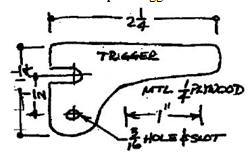
Mouse Trap Catapult
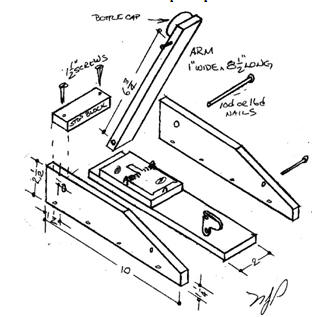
Baloo’s Archives
One of the great things about
being a Webelos Leader is the opportunity to learn many things along with the
boys. Unless you are an engineer, there may be some knowledge to pick up with
this activity badge to pass on to your
boys. Recruit the help of a
parent who is an engineer.
One of the purposes of Cub
Scouting is "fostering a sense of personal achievement by developing new
interests and skills" in boys. This activity badge probably does this more than
any of the other badges. Engineering is one of the most exacting of the
professions and the badge includes projects that will give a boy an insight into
some types of engineering.
Den Activities:
Arrange for boys to visit an engineer or surveyor in a
municipal county office. Plan for the boys to look through the surveyor's
manual and read a rod.
Visit a construction site and see the plans which are being
followed.
We visited
the new Ranger’s House while it was under construction out at our Scout Camp.
Everyone was very eager to show it off to us. Make sure you get permission
before visiting any construction site. CD
Visit the County water works, TV or radio station.
Have someone explain how to read topographic maps.
Have a builder or carpenter show and explain a floor plan
of a house.
Make a block and tackle. Be sure to explain its purpose.
Make catapults and demonstrate them at pack meeting,
shooting candies or marshmallows into the audience for distance.
Discuss property lines. Have a surveyor show how property
lines are determined and measured.
Discuss different types of engineers. If one can visit
your den, let him describe briefly what his duties are.
Have boys collect pictures of bridges and note the
differences in construction.
Take a field trip to an operating draw bridge (ex. St
Croix River), ship loading operation or other large industrial operation
involving large cranes or other lifting equipment.
Fields Of Engineering
Aeronautical Engineering: Deals with the whole
field of design, manufacture, maintenance, testing, and the use of aircraft both
for civilian and military purposes.
Astronautical Engineering: Closely related to
aeronautics, but is concerned with the flight of vehicles in space, beyond the
earth's atmosphere, and includes the study and development of rocket engines,
artificial satellites, and spacecraft for the exploration of outer space.
Chemical Engineering: Concerned with the design,
construction, and management of factories in which the essential processes
consist of chemical reactions.
Civil Engineering: Perhaps the broadest of the
engineering fields; deals with the creation, improvement, and protection of the
communal environment; providing facilities for living, industry, and
transportation, including large buildings, roads, bridges, canals, railroad
lines, airports, harbors, and other constructions.
Electrical Engineering/Computer Science: Divided
broadly into the engineering of electrical power distribution systems,
electrical machinery, and communication, information, and control systems.
Geological & Mining Engineering: Includes
activities related to the discovery and exploration of mineral deposits and the
financing, construction, development, operation, recovery, processing,
purification, and marketing of crude minerals and mineral products.
Industrial or Management Engineering: Pertains to
the efficient use of machinery, labor, and raw materials in industrial
production.
Mechanical Engineering: Broadly speaking, covers
the design and operation of all types of machinery and small structures.
Safety Engineering: Concerned with the prevention
of accidents.
Sanitary Engineering: A branch of civil engineering
that has acquired the importance of a specialized field due to its great
importance for a healthy environment, especially in dense urban population
areas.
Some Engineering Functions
Research: A search for new scientific knowledge,
with the objective of applying it to solving problems.
Development: Applied research which results in
working model.
Design: Conversion of developed ideas into
economical, reliable, and producible plans of manufacture, use or construction.
Maintenance: Plan and direct the methods of making
the design and transforming it into a useful product.
Sales: Define and explain the application of the
product and the sale of it.
Management: Administrate any or all of the
engineers which perform the functions listed above and any other personnel
required to perform the assigned task.
Field Trips
Adapted from
Heart of America Council
1)
Visit (with
permission) a housing project or a
commercial building construction site, possibly in conjunction with a visit by
an engineer as a guest speaker at your meeting.
2)
There are many big
engineering structures around our country – dams, bridges, towers, sewerage
plants, buildings, stadiums, power plants … Many times you can get an inside
tour of these structures that would fascinate your Webelos. However, I am not
sure how many have stopped (Like the Delaware Memorial Bridge near me) after
September 11. Many times there are even visitor centers near the structures
explaining how they were built. I never tire of seeing Hoover Dam constructed in
22 minutes on the screen in the museum in town. The Corps of Engineers office
at Clinton Lake, west of Lawrence, Kansas, has a display on the building of the
dam at the lake and how a dam works. Maybe you could combine some of these trips
with a fishing trip or nature hike at the lake made by the dam or a nearby state
park.
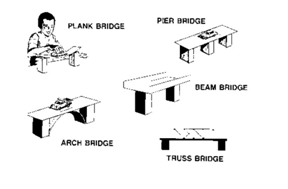
3)
Bridge Tour:
Heart of America Council had a route
for seeing various types of bridges in their area. I am sure with a little work
and a few phone calls you could come up with an itinerary for a bridge tour in
and around your town. CD
For an idea the HOAC
Route was -
a)
From the Heart of America bridge (Locust going north over the
Missouri River), to the east you can see a classical suspension bridge carrying
I-35. Also known as the Paseo bridge.
b)
West from the Heart of America bridge you can see two truss bridges
of different design and then the Broadway bridge which is a suspension bridge
suspended from arched girders.
c)
Further west, an arch bridge goes over 7th Street just north of I-35.
d)
The 12th Street bridge over the Kaw River is especially interesting.
The first span as you proceed north is a plank bridge, the next three spans are
classical cantilever, and the last is truss.
e)
Any number of pier type bridges can be seen in the area. The majority
of the bridges used in the Interstate systems are of this type. Be sure to
notice that while the bridges are pier type, the piers themselves are sometimes
cantilevered from side to side across the roadway.
In my area we have
Classical suspension –
Delaware Memorial, Walt Whitman, Ben Franklin, George Washington
The very first modern suspension bridge in
the US is the Wiliamsburg Bridge in New York city. It was 100 years old on
December 19, 2003!! CD
Cantilever – Delaware
Route 1 over the C&D Canal, Commodore Barry Brige
Arch – I-95 over the
Brandywine River
Steel Arch – Bayonne
Bridge
In a 5 mile section of
Delaware SR 1 between Smyrna and Dover in Kent County, Delaware, there are seven
bridges. Two bridges are dual, single-span steel beam bridges. Three bridges
are two-span, steel girder bridges. The remaining two bridges are dual,
multi-span, pre-stressed concrete girder bridges.
I am sure, the more you
look at the bridges around your area, the more you'll realize that there are few
pure one-type bridges. Most are bridges that incorporate several design types
in one. For instance, many pier type bridges over the railroad tracks are arched
to provide strength while conserving materials.
Show How Electricity Comes to Our House
Circle Ten
Council
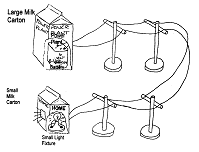
Make a small scale
electrical system
Equipment:
6 Volt
Battery Wooden Dowels
Insulated
wire 2 - Milk Cartons
Small Light fixture
Model Elevator
Circle Ten
Council
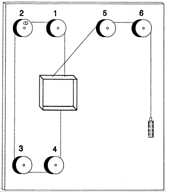
Nail Thread spools loosely to board, sip string over 1,2,3
and 4. Wind string several times around 2. Wind second string over 5 and 6 and
attach weight for balance. Turn handle on 2 to move car up and down.
Materials found in Baloo's Bugle may be used by Scouters for Scouting activities provided that Baloo's Bugle and the original contributors are cited as the source of the material. |
|





